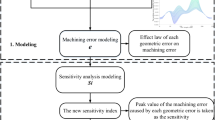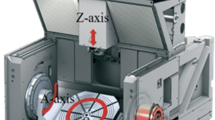Abstract
The geometric errors have a significant effect on the machining accuracy of multi-axis machine tool. Because of their complex inter-coupling, the process to control these geometric errors and then to improve the machining accuracy on this basis is recognized as a difficult problem. This paper proposes a method based on the product of exponential (POE) screw theory and Morris approach for volumetric machining accuracy global sensitivity analysis of a machine tool. When a five-axis machine tool is chosen as an example, there are five screws to represent the six basic error components of each axis (in an original way) according to the geometric definition of the errors and screws. This type of POE model is precise and succinct enough to express the relation of each of the components as the Morris method is based on the elementary effect (EE). The method can compare incidence of these errors and be used to describe the nonlinear relationship by less calculated amount in a global system. Based on the POE modelling, the Morris method is adopted to identify the key geometric errors which have a greater influence on the machining accuracy by global sensitivity analysis. Finally, according to the results obtained from analysis, suggestions, and guidelines are provided to adjust and modify the machine tool components to improve the machining accuracy economically.
Similar content being viewed by others
References
Kvrgic V, Dimic Z, Cvijanovic V, Ilic D, Bucan M (2012) A control algorithm for a vertical five-axis turning centre. Int J Adv Manuf Technol 61(5-8):569–584
Cheng Q, Feng Q, Liu Z, Gu P, Cai L (2014) Fluctuation prediction of machining accuracy for multi-axis machine tool based on stochastic process theory. Proc Inst Mech Eng C J Mech Eng Sci 0954406214562633
Hong C, Ibaraki S, Matsubara A (2011) Influence of position-dependent geometric errors of rotary axes on a machining test of cone frustum by five-axis machine tools. Precis Eng 35(1):1–11
Liu H, Li B, Wang X, Tan G (2011) Characteristics of and measurement methods for geometric errors in CNC machine tools. Int J Adv Manuf Technol 54(1-4):195–201
Schwenke H, Knapp W, Haitjema H, Weckenmann A, Schmitt R, Delbressine F (2008) Geometric error measurement and compensation of machines—an update. CIRP Ann-Manuf Technol 57(2):660–675
Ziegert JC, Kalle P (1994) Error compensation in machine tools: a neural network approach. J Intell Manuf 5(3):143–151
Wang J, Guo J (2013) Algorithm for detecting volumetric geometric accuracy of NC machine tool by laser tracker. Chin J Mech Eng 26(1):166–175
Ramesh R, Mannan MA, Poo AN (2000) Error compensation in machine tools—a review: Part I: geometric, cutting-force induced and fixture-dependent errors. Int J Mach Tools Manuf 40(9):1235–1256
Lamikiz A, De Lacalle LL, Ocerin O, Díez D, Maidagan E (2008) The Denavit and Hartenberg approach applied to evaluate the consequences in the tool tip position of geometrical errors in five-axis milling centres. Int J Adv Manuf Technol 37(1-2):122–139
de Lacalle NL, Mentxaka AL (Eds.) (2008) Machine tools for high performance machining. Springer Science & Business Media
Kvrgic V, Dimic Z, Cvijanovic V, Vidakovic J, Kablar N (2014) A control algorithm for improving the accuracy of five-axis machine tools. Int J Prod Res 52(10):2983–2998
Tian W, Gao W, Zhang D, Huang T (2014) A general approach for error modeling of machine tools. Int J Mach Tools Manuf 79:17–23
Fu G, Fu J, Xu Y, Chen Z (2014) Product of exponential model for geometric error integration of multi-axis machine tools. Int J Adv Manuf Technol 71(9-12):1653–1667
Rahman M, Heikkala J, Lappalainen K (2000) Modeling, measurement and error compensation of multi-axis machine tools. Part I: theory. Int J Mach Tools Manuf 40(10):1535–1546
Eman KF, Wu BT, DeVries MF (1987) A generalized geometric error model for multi-axis machines. CIRP Ann-Manuf Technol 36(1):253–256
Schiehlen W (1997) Multibody system dynamics: roots and perspectives. Multibody Syst Dyn 1(2):149–188
Fan JW, Guan JL, Wang WC, Luo Q, Zhang XL, Wang LY (2002) A universal modeling method for enhancement the volumetric accuracy of CNC machine tools. J Mater Process Technol 129(1):624–628
Chen IM, Yang G, Tan CT, Yeo SH (2001) Local POE model for robot kinematic calibration. Mech Mach Theory 36(11):1215–1239
Moon SK, Moon YM, Kota S, Landers RG (2001) Screw theory based metrology for design and error compensation of machine tools. In Proceedings of DETC, 1;697–707
Nojedeh MV, Habibi M, Arezoo B (2011) Tool path accuracy enhancement through geometrical error compensation. Int J Mach Tools Manuf 51(6):471–482
Xu C, Gertner G (2007) Extending a global sensitivity analysis technique to models with correlated parameters. Comput Stat Data Anal 51(12):5579–5590
Saltelli A, Ratto M, Tarantola S, Campolongo F, Commission E (2006) Sensitivity analysis practices: Strategies for model-based inference. Reliab Eng Syst Saf 91(10):1109–1125
Sudret B (2008) Global sensitivity analysis using polynomial chaos expansions. Reliab Eng Syst Saf 93(7):964–979
Shahsavani D, Grimvall A (2011) Variance-based sensitivity analysis of model outputs using surrogate models. Environ Model Softw 26(6):723–730
Nossent J, Elsen P, Bauwens W (2011) Sobol’sensitivity analysis of a complex environmental model. Environ Model Softw 26(12):1515–1525
Tsutsumi M, Saito A (2003) Identification and compensation of systematic deviations particular to 5-axis machining centers. Int J Mach Tools Manuf 43(8):771–780
Cheng Q, Wu C, Gu P, Chang W, Xuan D (2013) An analysis methodology for stochastic characteristic of volumetric error in multiaxis CNC machine tool. Math Probl Eng 2013
Morris MD (1991) Factorial sampling plans for preliminary computational experiments. Technometrics 33(2):161–174
Campolongo F, Cariboni J, Saltelli A (2007) An effective screening design for sensitivity analysis of large models. Environ Model Softw 22(10):1509–1518
King DM, Perera BJC (2013) Morris method of sensitivity analysis applied to assess the importance of input variables on urban water supply yield–a case study. J Hydrol 477:17–32
Touhami HB, Lardy R, Barra V, Bellocchi G (2013) Screening parameters in the Pasture Simulation model using the Morris method. Ecol Model 266:42–57
Ruano MV, Ribes J, Seco A, Ferrer J (2012) An improved sampling strategy based on trajectory design for application of the Morris method to systems with many input factors. Environ Model Softw 37:103–109
Herman JD, Kollat JB, Reed PM, Wagener T (2013) Technical note: method of Morris effectively reduces the computational demands of global sensitivity analysis for distributed watershed models. Hydrol Earth Syst Sci 17(7):2893–2903
Li Y, Zhu M, Li Y (2006) Kinematics of reconfigurable flexible-manipulator using a local product-of-exponentials formula. In Intelligent Control and Automation, 2006. WCICA 2006. The Sixth World Congress on, 2; 9022-9026. IEEE
He R, Zhao Y, Yang S, Yang S (2010) Kinematic-parameter identification for serial-robot calibration based on POE formula. Robot IEEE Trans 26(3):411–423
Liu W, Liang M (2008) Multi-objective design optimization of reconfigurable machine tools: a modified fuzzy-Chebyshev programming approach. Int J Prod Res 46(6):1587–1618
Zhang G, Ouyang R, Lu B, Hocken R, Veale R, Donmez A (1988) A displacement method for machine geometry calibration. CIRP Ann-Manuf Technol 37(1):515–518
Chen G, Yuan J, Ni J (2001) A displacement measurement approach for machine geometric error assessment. Int J Mach Tools Manuf 41(1):149–161
Author information
Authors and Affiliations
Corresponding author
Rights and permissions
About this article
Cite this article
Cheng, Q., Feng, Q., Liu, Z. et al. Sensitivity analysis of machining accuracy of multi-axis machine tool based on POE screw theory and Morris method. Int J Adv Manuf Technol 84, 2301–2318 (2016). https://doi.org/10.1007/s00170-015-7791-x
Received:
Accepted:
Published:
Issue Date:
DOI: https://doi.org/10.1007/s00170-015-7791-x




